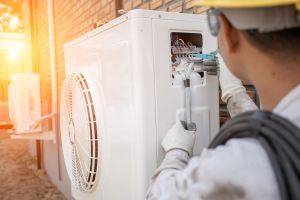Recent guideline updates offer real-world approach to energy savings
Recently updated guidelines for energy savings offer homeowners and businesses cool (and warm) ways to save energy – and money – with Power Moves rebates.
This year, Power Moves rebate application submissions for heating and cooling upgrades require Heating Seasonal Performance Factor 2 (HSPF2) and Seasonal Energy Efficiency Ratio (SEER2) ratings. The new ratings system went into effect in 2023 and are the energy efficiency metrics for residential air conditioners and heat pumps, according to the Air-Conditioning, Heating, and Refrigeration Institute (AHRI). The goal of the U.S. Department of Energy’s new testing is to “reflect field conditions more accurately,” AHRI reported on its website.

A technician works on an air source heat pump. Power Moves applications now require the new HSPF2 and SEER2 ratings for heat load calculations as part of applications.
“The new ratings really were designed to be more accurate with real world situations,” said Joe Spear, energy advisor for Carroll White REMC. “When you go to AHRI and it was the original SEER and HSPF ratings, they were lab tested. You didn’t have the imperfections or different scenarios that are happening in homes and different residential settings.”
If new heating and cooling equipment installed in a home do not have new HSPF2 and SEER2 ratings available, the Power Moves rebate applications include instructions to calculate the new figures based on the HSPF and SEER ratings previously used.
The new measurements are part of the Department of Energy’s effort to reduce overall energy use in the U.S., AHRI reported. The Power Moves program, which offers rebates to homeowners and businesses upgrading to energy efficient equipment, shares a similar goal to lower long-term energy use.
The Power Moves program has also updated rebates: homeowners can now qualify for up to $1,800 for upgrading to a cold climate air source heat pump, up from a $1,500 rebate in 2023.
“It’s not your father’s heat pump anymore,” said Laura Matney, strategic electrification and member relations manager for Wabash Valley Power Alliance, which administers the Power Moves program with its 23 Midwestern member electric cooperatives. “Cold climate air source heat pumps are still very efficient at only 5 degrees outside, and even when temperatures fall below zero. It helps the home be more effective and cost efficient, and it helps us with trying to help reduce peak demand for electricity. That helps maintain grid stability.”
Cold climate heat pumps also have a coefficient of performance (COP) rating that indicates how efficient they operate at 5 degrees Fahrenheit. Cold climate air source heat pumps with higher COP ratings mean they are more efficient than alternative options.
Even with the different ratings, each homeowner should consider all options before making a purchase. A home with electric resistance backup heat is going to have different electricity needs compared to a home with a natural gas or propane backup furnace. Tax credits in the Inflation Reduction Act may also make some options more affordable for some homeowners than others, though tax experts should be consulted to determine eligibility.
“The different ratings are all guidelines,” said Spear, who supports Carroll White REMC members with home-related energy questions and issues. “They all correlate, and they all highlight the efficiency of different systems in the heating or cooling seasons. That’s the way I see them.”